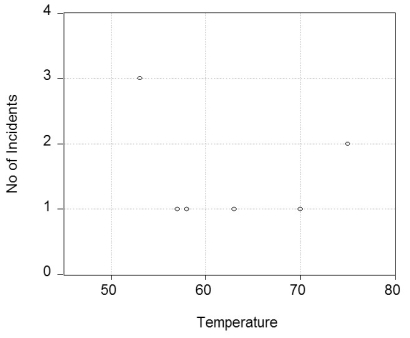The Report of the Presidential Commission on the Space Shuttle Challenger Accident in 1986 shows a plot of the calculated joint temperature in Fahrenheit and the number of O-rings that had some thermal distress. You collect the data for the seven flights for which thermal distress was identified before the fatal flight and produce the accompanying plot.  (a)Do you see any relationship between the temperature and the number of O-ring failures? If you fitted a linear regression line through these seven observations, do you think the slope would be positive or negative? Significantly different from zero? Do you see any problems other than the sample size in your procedure?
(a)Do you see any relationship between the temperature and the number of O-ring failures? If you fitted a linear regression line through these seven observations, do you think the slope would be positive or negative? Significantly different from zero? Do you see any problems other than the sample size in your procedure?
(b)You decide to look at all successful launches before Challenger, even those for which there were no incidents. Furthermore you simplify the problem by specifying a binary variable, which takes on the value one if there was some O-ring failure and is zero otherwise. You then fit a linear probability model with the following result, = 2.858 - 0.037 × Temperature; R2 = 0.325, SER = 0.390,
(0.496)(0.007)
where Ofail is the binary variable which is one for launches where O-rings showed some thermal distress, and Temperature is measured in degrees of Fahrenheit. The numbers in parentheses are heteroskedasticity-robust standard errors.
Interpret the equation. Why do you think that heteroskedasticity-robust standard errors were used? What is your prediction for some O-ring thermal distress when the temperature is 31°, the temperature on January 28, 1986? Above which temperature do you predict values of less than zero? Below which temperature do you predict values of greater than one?
(c)To fix the problem encountered in (b), you re-estimate the relationship using a logit regression:
Pr(OFail = 1 | Temperature)= F (15.297 - 0.236 × Temperature); pseudo- R2=0.297
(7.329)(0.107)
What is the meaning of the slope coefficient? Calculate the effect of a decrease in temperature from 80° to 70°, and from 60° to 50°. Why is the change in probability not constant? How does this compare to the linear probability model?
(d)You want to see how sensitive the results are to using the logit, rather than the probit estimation method. The probit regression is as follows:
Pr(OFail = 1 | Temperature)= Φ(8.900 - 0.137 × Temperature); pseudo- R2=0.296
(3.983)(0.058)
Why is the slope coefficient in the probit so different from the logit coefficient? Calculate the effect of a decrease in temperature from 80° to 70°, and from 60° to 50° and compare the resulting changes in probability to your results in (c). What is the meaning of the pseudo- R2? What other measures of fit might you want to consider?
(e)Calculate the predicted probability for 80° and 40°, using your probit and logit estimates. Based on the relationship between the probabilities, sketch what the general relationship between the logit and probit regressions is. Does there seem to be much of a difference for values other than these extreme values?
(f)You decide to run one more regression, where the dependent variable is the actual number of incidences (NoOFail). You allow for a different functional form by choosing the inverse of the temperature, and estimate the regression by OLS. = -3.8853 + 295.545 × (1/Temperature); R2 = 0.386, SER = 0.622
(1.516)(106.541)
What is your prediction for O-ring failures for the 31° temperature which was forecasted for the launch on January 28, 1986? Sketch the fitted line of the regression above.
Definitions:
Environmentally Conscious
Being aware of the environmental impact of one's actions and making decisions that aim to reduce negative effects on the planet.
Employee Empowerment
A management practice of giving employees the autonomy, resources, and skills to make decisions and contribute to company goals.
Technical Skills
Specific knowledge or abilities required for a particular job or activity, often relating to competence in a certain craft or technology.
Cognitive Skills
The mental capabilities involved in learning, thinking, problem-solving, and decision-making.
Q5: At the Stock and Watson (http://www.pearsonhighered.com/stock_watson)website go
Q15: The following statement about the sample
Q18: The construction of the t-statistic for a
Q18: ARCH and GARCH models are estimated using
Q22: To test whether or not the population
Q28: When testing joint hypothesis, you can use<br>A)the
Q28: You try to establish that there is
Q29: A study tried to find the
Q46: You have collected data for 104
Q48: When the central bank buys $5,000,000 worth